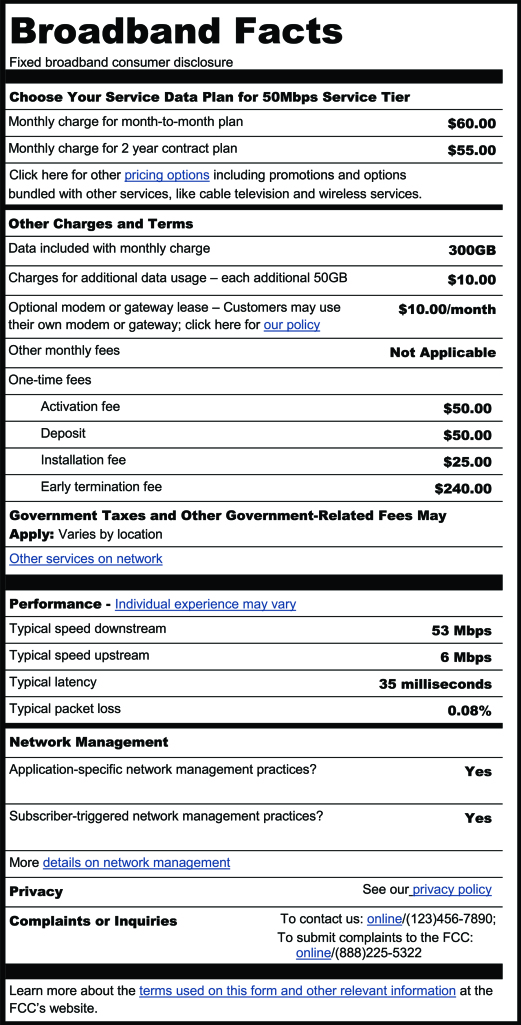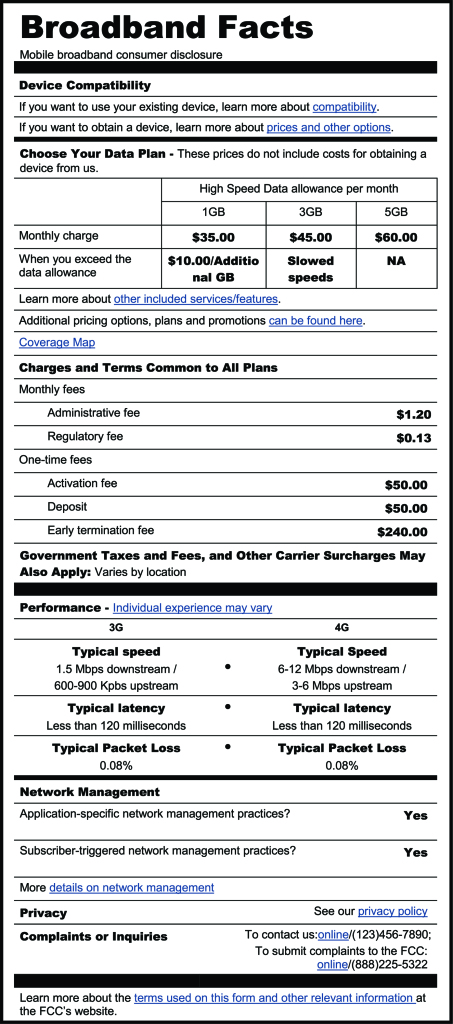FCC, CFPB Announce Nutrition-Like Labels For Broadband
When the FCC narrowly approved the Open Internet Order a year ago, most of the discussion involved “net neutrality” — the rules against Internet service providers being able to block, slow down, or prioritize access to specific sites and content. However, the Order also contained new transparency rules requiring broadband providers to, well, be more transparent with consumers, which is why today the FCC announced a new labeling system to help keep consumers informed.
FCC Chairman Tom Wheeler — along with Richard Cordray, director of the Consumer Financial Protection Bureau — unveiled a new “Consumer Broadband Label” designed to let buyers of broadband services (i.e., anyone signing up for a home or mobile data plan) make consistent comparisons between services while shopping for plans.
If the idea of labels you can consistently compare across packaging on every brand sounds familiar, well, there’s a reason for that. The new broadband labels actually do look a lot like the nutritional labels we’ve all been used to for decades, only instead of telling us about calories, carbs, zinc, and sodium, they tell us about average speeds, data caps, and monthly charges.
“If you are going to get competition, competition, competition,” Wheeler said, referring to his frequent mantra for broadband, “you need information, information, information. The more consumers know, the better the opportunity for competition.”
“What we are unveiling today is a simplified approach to the presentation of the core information that consumers need to make an informed purchase decision,” Wheeler continued.
“We relied heavily on the CFPB as we developed this because of their expertise helping explain, in similar kinds of boxes, exactly what is going on in the financial realm, and that experience working with consumers they shared with us and it had a significant impact on what we did,” said Wheeler.
“Consumers deserve to know before they owe, with clear, upfront information about the prices, risks, and terms of the deal,” Cordray added. “Broadband is quickly becoming a necessary part of everyday life for millions of consumers.”
The formal order adopting the labels finds that the proposed “nutritional” style labels “display these terms in plain language that is easy to understand without overwhelming consumers with too much information,” which is the tricky line to walk with disclosure notices of any kind.
The proposed labels come in both fixed (i.e. home service from a cable company) and wireless (i.e. your mobile phone) versions. The labels for both types of data are fairly comprehensive, and should, ideally, allow for an apples-to-apples comparison of features, costs, and limitations across plans.
They even include mention of those various surcharges and fees we’ve seen appear across almost every carrier’s bills.
For example, the template for fixed broadband installation includes categories outlining the monthly cost, the one-time costs, and the hardware rental costs. It also includes description of the typical downstream and upstream speeds, latency, and packet loss — not the “up to [X]” speed that carriers typically advertise.
On top of all that, it also mentions what the data cap is, and what network management practices are at play.
The instructions on the template given to providers are explicit, saying that “other monthly fees” needs to include “any monthly fees that the company chooses to impose in connection with the purchase of broadband service, e.g., regulatory recovery fees,” and basically any other fee that isn’t mandated by the subscriber’s state and local governments.
The instructions also provide that the “typical speed” given needs to be the “typical peak usage download speed for this tier of service,” which works around the issue of an “up to [X]” speed realistically only being attainable at 3 a.m.
The mobile version is a lot like the fixed version, but has some different features. The monthly costs of data plans, for example, do not include the costs of buying a new phone — a significant but highly variable expenditure for most consumers.
However, the mobile version, like its fixed sibling, not only indicates what the data cap is on purchased plans, but also what happens if you should happen to exceed that cap: whether you are charged for excess data, have your speed throttled, or have your service cut off until the billing period resets.
The mobile label also includes one-time fees and recurring monthly fees, as applicable, and outlines typical performance for connection on mobile broadband networks.
The mobile instructions are also explicit, requiring providers to delineate typical performance for both the primary network for the plan (4G LTE, 3G, etc) and also other networks available.
In a statement, the FCC said the commission receives more than 2000 complaints every year about “surprise fees” on internet service bills. The actual cost can be up to 40% more than advertised, they (and we) have found.
So this is a way to fix that, chairman Wheeler said.
“This is a no-surprises before you buy — actually, I should restate: this is a no-surprises after you buy, because you know when you buy, kind of situation,” Wheeler said.
“Hidden fees have no place to hide. They’re all laid out there.”
Cordray echoed that sentiment, saying, “It is important for consumers to be able to look to see what is there … and it is important that the comparisons be apples to apples, which will affect industry behavior because fees cannot be hidden, they can’t pop up later.”
So all this disclosure sounds great, right? But here’s the catch: ISPs are not actually being required to use these disclosure labels.
The open internet rule does include a transparency requirement, and ISPs are (or at least, will soon be) legally bound to meet that requirement. However, they don’t have to do it in this way; they can still choose an alternative. The FCC is encouraging use of the broadband label, though, by granting “safe harbor” status. Basically, if an ISP fills out and applies this label to the best of their ability, they will be considered in compliance with the rule — with the implication that if the label itself is later found faulty or overturned, the ISPs won’t be held responsible or considered in violation of the transparency rule.
The other challenge? Being able to compare ISPs against each other is great if you happen to have more than one option available to subscribe to. However, tens of millions of Americans effectively live in monopoly territories where competitive options don’t really exist.
Want more consumer news? Visit our parent organization, Consumer Reports, for the latest on scams, recalls, and other consumer issues.



